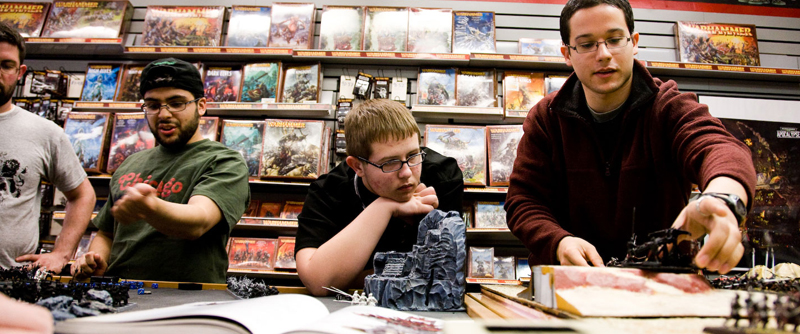Though squashed into a strip of bland chain stores, Games Workshop embraces an entirely different reality. Outside on Greenwich Village’s Eighth Street, you pass another Subway, ‘Wichcraft and Chipotle; inside, Dwarves brandish axes to defend their homeland against Skaven, evil rat-men who scheme to take control of all other races, while gamers fight to survive — manning miniature models on a four by six-foot tabletop, that is.
Acrid paint fumes waft around the small store, mingling with the even sharper odor of too many sweaty boys, and men. When they’re not playing, they’re building and painting their armies, right in the store. Although the stereotypical nerds show up at Games Workshop (or GW, as the gamers call it), there’s quite a variety of people here. Sometimes you can meet the bright-eyed, 11-year old Alex, or run into Austin, who is in his thirties and getting his doctorate at NYU, or laugh with Ricky, who jokes that he comes to GW to get away from the wife. You can usually talk with David, a 19-year old who calls himself a veteran of the game but really isn’t that good, with no strategy to his fights.
On one of the three tables, a battle rages among the inch-and-a-half high figures, called models. An Ork battalion threatens to decimate a Skaven Deathmaster Snikch, a feared rat assassin wielding two thick, bloody swords. John, a long-haired 20-year-old in a T-shirt and ripped jeans, looks worriedly at his beloved rats, but his opponent, a loud 24-year-old Puerto Rican guy with a Mohawk, in baggy black pants and chains, commands most of the attention in the room.
That’s Joseph Cruz. His friends call him Joe, but he likes to be called Warboss Zagdakka, which in Orkish means “really fast and loud.” He plays with the all-powerful Ork forces, which he describes as “stupid, ugly as fuck, and really kickass.”
Warboss Zagdakka wears square, black-framed glasses, and his chiseled jaw is covered in light stubble. Standing at about 5’10 and 135 pounds, he carries himself with a grungy nonchalance. He shakes a pair of dice in his tanned hands and throws them across the table. He knows he’s going to win; his Orks haven’t lost a battle yet. He rolls up the sleeves of his black hoodie, revealing colorful tattoos creeping up his arms, culminating in a bloody vampire bite on his neck. His tattoos include tribal symbols and Japanese Kanji characters (“direction” and “control”) on each wrist. Scattered along his right arm is a series of yellow faces with varied expressions. He clarifies: “It doesn’t matter if you’re happy, if you feel sad, sick, or like an asshole. It doesn’t matter; you will die.”
Joe’s voice shoots out of his mouth like a bullet exploding from a gun. When he’s nervous, you can barely understand him. He turns away from you often to focus on the game, yelling out exclamations, like “This is tactic #1 – you should probably get the fuck out of there little guy,” and “I don’t have a military structure, shit!”
When you ask Joe if he’s good at Warhammer, he replies, “Sometimes I’m good at it and – fuck! I’m getting a lot of damage! Rest of fleet, engage!” (He can get so absorbed in the battle that he forgets you are there.) After getting to know him, I can predict what he’ll say: “Sometimes I’m good at it and sometimes I’m just fucking awesome!”
The game itself isn’t all that aggressive, and is bound by strict rules. It takes place entirely on the tabletop. Opposing players line up their figures on opposite sides of the table, and before beginning decide how many turns each will take. During each turn, the players move through three phases: movement (units and soldiers travel across the tabletop); shooting (long-distance attacks); and assault (close-range attacks). During each phases, players roll dice to determine actions, such as whether their attacks will hit or miss, whether their soldiers will be wounded, or whether they’ll get to run away. When the turns finish, the game ends, no matter who is left dead or alive. Then each player counts up the number of enemies he’s killed (some figures, or models, are worth more points than others). The player with the highest number of points wins. Battles can last anywhere from hours to days — and multiple battles can be combined to form a campaign.
A veteran gamer describes Joe and his friend John — they started coming to the store together in January 2008 — as “joined at the hip.” But an employee, Kerrigan, thinks of them as “the polar opposites of gaming.” Playing John is always a good time, even if you’re getting “pwned” (beaten), he explained, but playing Joe is more frustrating because he does whatever it takes to win.
“Joe is a power gamer, and if you want a fun game, you don’t play Joe,” says Michael, another employee. “Joe’s a good guy, off the tabletop.”
“Who said that?” Joe later wants to know. “Red-shirt Mike who has never played me?”
Joe refutes the notion of being a “power gamer” – someone who abuses any loopholes in the rules in order to win. He claims that having a good time is the most important thing, but he quickly adds, “Obviously no one plays to lose, or else, why play?”

